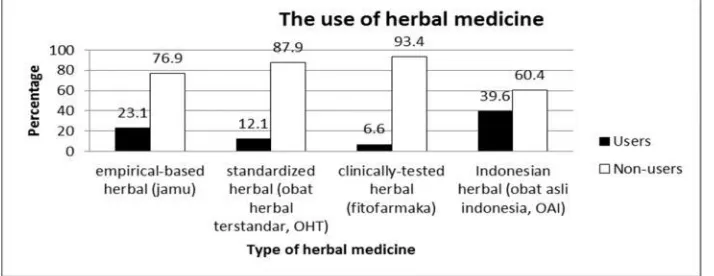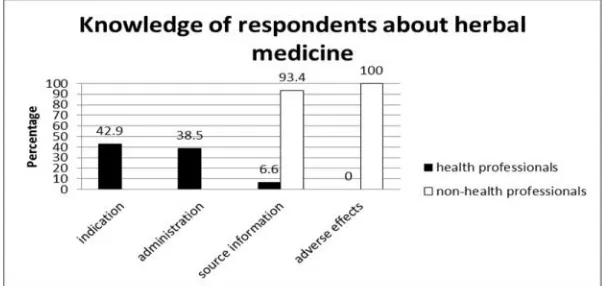Proceedings of The 5th Annual International Conference Syiah Kuala University (AIC Unsyiah) 2015
In conjunction with The 8th International Conference of Chemical Engineering on Science and Applications (ChESA) 2015 September 9-11, 2015, Banda Aceh, Indonesia
309
The use of herbal medicine in children
1*Suryawati, and 1Hijra Novia Suardi
1Department of Pharmacology, Medical Faculty, Syiah Kuala University, Banda Aceh 23111,
Indonesia;
*Corresponding Author: suryawatie@gmail.com
Abstract
The herbal medicine has been widely used in children for the treatment of several symptoms and the prevention of diseases before accessing the hospital for professionals help. There are 3 kinds of marketed herbal medicine including empirical based herbal medicine (jamu), standardized herbal medicine (obat herbal terstandar) and clininically tested herbal medicine (fitofarmaka). This study aimed to investigate the utilization of the marketed herbal medicine along with non marketed ones which was known as the Indonesian original herbal medicine (Obat Asli Indonesia, OAI) in children. The cross sectional study was conducted by interviewing 91 parents whose children were hospitalized in RSUD Meuraxa, Banda Aceh. The interview was conducted using a structured questionnaire from 4 to 29 September 2014. The result showed that the Indonesian original herbal medicine was used most frequently followed by herbal (jamu), standardized herbal and clininically tested herbal medicine. The utilization of herbal medicine was associated with the knowledge of parents and did not correlate to their economic level. All of the parents did not know the side effects of herbal medicine to their children’s body and few of them knew the indication of herbal remedies. Overall, it was concluded that eventhough the knowledge of parents about the safety and activity of herbal medicine was not sufficient the use of herbal medicine in children was common.
Key words: empirical based herbal, standardized herbal, clinically tested herbal
Introduction
According to the Book of Policy in National Traditional Medicine (Minister of Health of Republic of Indonesia, 2007), there are more than 9600 species known to have therapeutic activities and 300 species have been used by pharmacy companies. This indicates that herbal medicines have been progressively accepted by society as the substitutes or additional treatment of conventional drugs. In response to the rising use of herbal medicine, Indonesian government has issued the regulation which classifies the marketed herbal products into 3 group based on their data in efficacy and safety. They
are herbal (jamu), standardized herbal, known as obat herbal terstandar (OHT) and clininically tested
herbal medicine, known as fitofarmaka. Jamu has been used empirically for decades without any
experimental data. The standardized herbal has been evaluated experimentally in animals, whereas clinically tested herbal medicine has been examined in human bodies (NA-DFC, 2005). The plant cultivated for therapeutic uses is known as Indonesia’s herbal medicines.
The herbal medicines have been available in drug stores so that can be obtained without prescription and professionals monitoring. This practices could lead to the mistreatment that can harm the body, especially in children. The administration of any therapeutic agents into children’s body should consider the anatomy and physiology of their body. The development level of organs such as brain, liver, and kidney affects rate of the absorption, distribution and metabolism and excretion of drugs. The inappropriate doses could lead to the accumulation of drugs in the body and finally cause the toxic effects. The unstandardized preparation of herbal medicines by manufacturer and contaminants (metals, chemical drugs, etc) poses risks for children’s health (Woolf, 2003). Parents should seek advice and inform health parctitioners when herbal medicines are used to prevent the negative
interactions (Gilmor et al., 2011). Several herbal-drug interaction has been noted . for example, the
use of garlic (Allium sativum) in children who take paracetamol at the same time would affects the
pharmakocinetics profile of paracetamol (Myers et al., 2004). The adequate knowledge of parents is
essential when herbal remedies is taken. There are several reasons why parents decide to use herbal such as the beliefs that herbal is safe and more effective because it comes from nature, the cost, the distance to reach public health facilities, etc (Ekor, 2013). There is limited data available about the utilization of herbal medicines in Banda Aceh so that this study was conducted.
Materials and Methods
Proceedings of The 5th Annual International Conference Syiah Kuala University (AIC Unsyiah) 2015
In conjunction with The 8th International Conference of Chemical Engineering on Science and Applications (ChESA) 2015 September 9-11, 2015, Banda Aceh, Indonesia
310
1). Identity of children and parents
2). The practice of using herbal medicine and the type of herbal used before hospitalization
3). The knowledge of parents about herbal medicine (indications, the period of using, source of information and adverse effects )
Data were presented descriptively. The relation between the use of herbal medicine and the parents
knowledge and their economic level were identified using chi square test. The definition of herbal
(jamu), standardized herbal (obat herbal terstandar (OHT)), clininically tested herbal medicine
(fitofarmaka ) and the their brand names were explained to respondents before interview was carried out.
Results and Discussion
This study involved 91 children hospitalized in regional hospital meuraxa. The demographic characteristics are shown in Table 1. Most of the children (53.8%) were from middle-income family.
Table 1. Characteristic of respondent
Herbal medicine n %
Age
6-10 36 39.6 11-14 28 30.8 15-18 27 29.7
Gender
Boys 51 56 Girls 40 44
Economic status
Low income 19
20.9
Middle-income 49
53.8
High-income 23 25.3
Recently, this is the first study that identifies the use of marketed herbal and non-marketed ones. The
marketed herbal includes empirical-based herbal (jamu), standardized herbal and clinical-tested
herbal (fitofarmaka), whereas the non-marketed herbal is known as Indonesian herbal medicine.
Figure 1. The use of herbal medicine
The utilization of herbal medicine was increased with the availability of the herbal. Out of 91 patients, 39.6 % used Indonesian herbal medicine. Indonesian herbal medicine is part of plants cultivated coventionally for diseases treatment and health maintenance. Since the plants were easily obtained, people used the herbal as the first treatment to prevent the more serious symptoms before accessing public health service. Among the respondents, 23.1% consumed empirical-based herbal, 12.1% used
standardized herbal and 6.6 % take clinically tested herbal. The safety and efficacy of fitofarmaka had
Proceedings of The 5th Annual International Conference Syiah Kuala University (AIC Unsyiah) 2015
In conjunction with The 8th International Conference of Chemical Engineering on Science and Applications (ChESA) 2015 September 9-11, 2015, Banda Aceh, Indonesia
Figure 2. Knowledge of respondents about herbal medicine
Information about the herbal medicine was mostly transferred from non-health professionals such as famillies, neighbours, etc. Less than 10% respondents gained the knowledge from health practitioners such as medical doctors, pharmacists, midwives, etc. This result confirmed the previous study in Nigeria which showed that health professionals did not contribute in the distribution of information
among society (Nwooru et al., 2015). A study in Malaysia also showed that parents were the main
source of information (Sooi et al., 2013). Only 42.9 % participants knew the indication of herbal
medicine and 38.5 % knew how long the herbal should be applied. There was no respondent knew the adverse effects of using herbal medicine.
Table 2. The use of herbal medicine based on respondent’s knowledge
Table 3. The use of herbal medicine based on the economic status of respondent
The parents with good knowledge tended to use herbal medicine for their children (table 2). This result consistent with a study in Australia which found that the users of alternative medicine
commonly were well-educated (Wilson et al, 1996). The users were commonly in the middle and high
income families. The majority of children from low income families were non-users. The other study in
Germany (Yong Du et al., 2014) indicated that people from high class society were more likely to be
the users of herbal medicine. The statistical analysis concluded there was correlation between the use of herbal medicine and the parents knowledge but no correlation with their economic status.
Conclusions
Overall, the number of users of non-marketed herbal were more than marketed ones. The number of users of each type of herbal increased with the availability of the herbal for each indications. There was correlation between the practices of using herbal with the parents knowledge. The economic status was not associated with the use of herbal.
Acknowledgements
Proceedings of The 5th Annual International Conference Syiah Kuala University (AIC Unsyiah) 2015
In conjunction with The 8th International Conference of Chemical Engineering on Science and Applications (ChESA) 2015 September 9-11, 2015, Banda Aceh, Indonesia
312
References
Ekor, M. (2013). The growing use of herbal medicines: issues relating to adverse reactions and challenges in monitoring safety. Front Pharmacol, 4: 177
Gilmour, J., Harrison, C., Asadi, L., Cohen, MH. dan Vohra, S. (2011). Natural Health Product–Drug Interactions: Evolving Responsibilities to Take Complementary and Alternative Medicine Into Account. Pediatrics, 128;S155
Ministry of Health of Republic of Indonesia. (2007). The Policy in National Traditional Medicine. Ministry of Health of Republic of Indonesia.
Myers, S. P. and Cheras, P. A. (2004). The other side of the coin: safety of complementary and alternative medicine. MJA, 181: 222–225
Nworu, C.S., Udeogaranya, P.O., Okafor, C.K., Adikwu A.O., Akah, P.A. (2015). Perception, usage and knowledge of herbal medicines by students and academic staff of University of Nigeria: A survey. European Journal of Integrative Medicine 7: 218–227
Sooi, L.K.,Keng, S.L. (2013). Herbal Medicines: Malaysian Women's Knowledge and Practice. Evid Based Complement Alternat Med. 2013: 438139.
The National Agency of Drug and Food Control (NA_DFC). (2005). Citing Internet sources URL http://jdih.pom.go.id
Woolf, AD. (2003). Herbal Remedies and Children: Do They Work? Are They Harmful? Pediatrics 2003; 112;240 Wilson, D.H., and Taylor, A. W. 1996. Prevalence and cost of alternative medicine in Australia. The
Lancet, 347: 569-573
Yong Du, Ingrid-Katharina Wolf, I.K., Zhuang, W., Bodemann, S., Knöss, W., and Knopf, H.(2014). Use of herbal medicinal products among children and adolescents in Germany. BMC Complementary and Alternative

